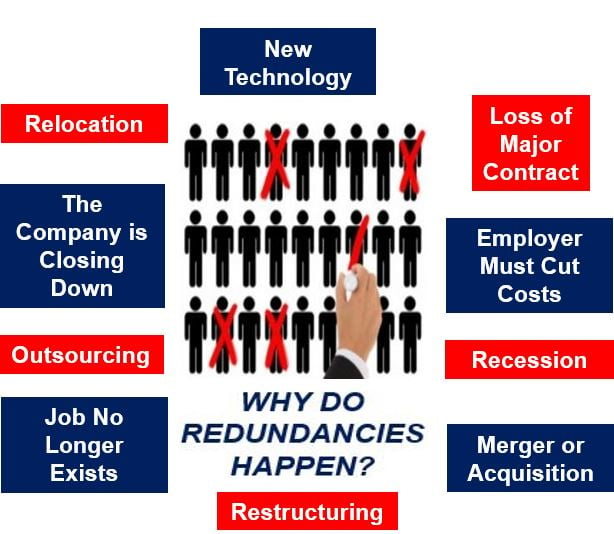Your Rights to Redundancy If Company Goes Bust: UK Employee Protections
Discovering the Operational Characteristics of Firm Redundancy and Its Long-Term Sustainability

Redundancy Strategies for Organization Continuity
In order to make sure nonstop procedures, organizations need to implement efficient redundancy strategies for organization continuity. Redundancy in this context refers to the duplication of important parts or functions within a system to alleviate the influence of potential failures. By including redundancy techniques, organizations can improve their strength versus disturbances brought on by numerous factors such as all-natural catastrophes, devices failings, or cyber-attacks.
One usual redundancy approach is the implementation of back-up systems and information storage space options. This entails developing duplicates of important information and systems that can be turned on in situation of a key system failure. Furthermore, companies can develop repetitive interaction networks and source of power to keep connection and procedures throughout unforeseen occasions.
In addition, cross-training employees to perform multiple roles within the firm can act as an important redundancy technique. If essential employees are unavailable due to ailment or various other reasons, this ensures that essential jobs can still be lugged out even. Overall, reliable redundancy strategies are important for services to maintain functional connection and reduce the effect of prospective disturbances.
Impact of Redundancy on Organizational Durability
Offered the critical duty redundancy methods play in making certain service connection, discovering the effect of redundancy on business durability becomes imperative for recognizing the alternative functional dynamics of a business. Organizational strength refers to an entity's capacity to adapt to disturbances, recuperate from problems, and change when required while keeping core features. Redundancy, when tactically executed, can significantly add to enhancing a company's resilience when faced with unanticipated difficulties. By having backup systems, employees, or processes in position, firms can better endure shocks and proceed operations with minimal interruption.
Furthermore, redundancy can foster innovation and creativity within a company as workers feel encouraged to take calculated risks, recognizing that there is a security net to sustain them in case of failing. On the whole, the effect of redundancy on organizational durability is profound, shaping the long-term sustainability and success of a company.
Stabilizing Effectiveness and Flexibility in Redundancy
Attaining an unified stability between functional effectiveness and adaptive flexibility is a pivotal obstacle in the calculated deployment of redundancy within companies. Effective operations are important for keeping productivity and cost-effectiveness, ensuring that resources are utilized efficiently. However, extreme emphasis on performance alone can cause rigidity, making it tough for organizations to adapt to unforeseen adjustments or challenges. On the various other hand, adaptability allows companies to respond nimbly to go now advancing situations, promoting innovation and durability. Yet, way too much versatility without a strong operational foundation can cause inefficiencies and inconsistency.
To stabilize performance and flexibility in redundancy preparation, organizations should thoroughly examine their functional needs, market characteristics, and critical goals. Inevitably, locating the best equilibrium in between efficiency and flexibility is vital for developing a sustainable and durable organization in the face of unpredictability.
Long-Term Sustainability Through Redundancy Planning
To guarantee long-lasting viability and stability, organizations should purposefully straighten their redundancy preparation with long-term sustainability goals, thus balancing operational effectiveness with flexible adaptability. Firms should see redundancy not as a responsive remedy to prompt troubles but as an aggressive strategy for long-term success.

Aggressive Actions for Sustainable Business Workflow
Just how can companies proactively boost their functional sustainability for long-term success? Carrying out aggressive measures is vital for business intending to ensure sustainable operations. One crucial method is to buy modern technology and advancement to enhance procedures, decrease waste, and stay competitive in the marketplace. Taking on lasting practices such as minimizing power intake, lessening carbon footprint, and optimizing resource usage can not only benefit the setting but also result in cost savings over time.
Furthermore, cultivating a society of constant enhancement and discovering within the company can improve adaptability to transforming market problems and consumer needs. Urging worker find out here now involvement in decision-making procedures and supplying possibilities for specialist advancement can increase spirits, efficiency, and overall performance. Establishing clear objectives, checking crucial performance indications, and frequently examining progress are vital parts of positive sustainability administration.
Collaborating with vendors, clients, and various other stakeholders to promote sustainable techniques throughout the supply chain can create a causal sequence of favorable impact - redundancy pay if company goes bust. By taking aggressive steps in the direction of operational sustainability, business can build strength, drive advancement, and secure their long-lasting success in an ever-evolving business landscape
Final Thought

In the realm of business monitoring, the critical implementation of firm redundancy stands as an essential yet elaborate technique that necessitates a fragile balance in between operational performance and long-lasting feasibility. By dissecting the functional dynamics that underpin company redundancy and examining its broader effects for organizational strength and adaptability, a nuanced understanding of just how redundancy techniques can form the future trajectory of a business starts to unfold.Offered the vital duty redundancy methods play in ensuring service connection, discovering the impact of redundancy on business strength becomes important for recognizing the holistic functional characteristics of a company. Generally, the influence of redundancy on organizational durability is extensive, forming the lasting sustainability and success of a company.
In final thought, recognizing the operational characteristics of firm redundancy is important for making certain long-term sustainability.